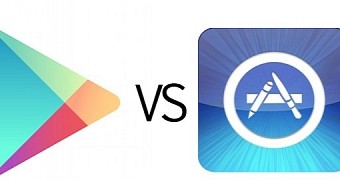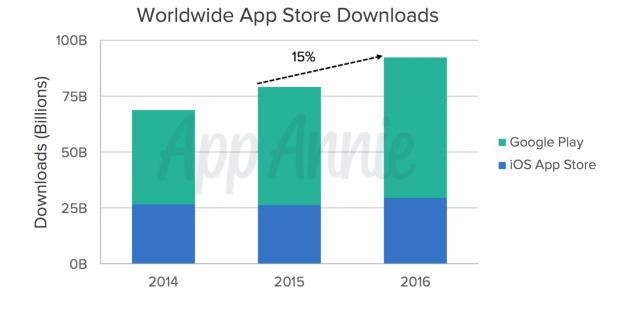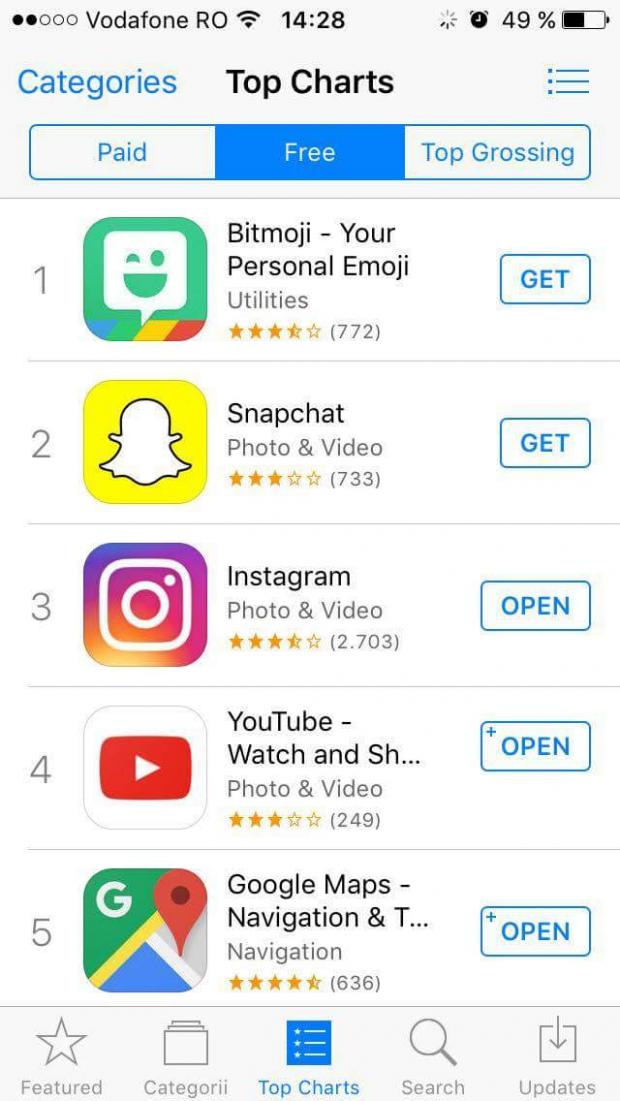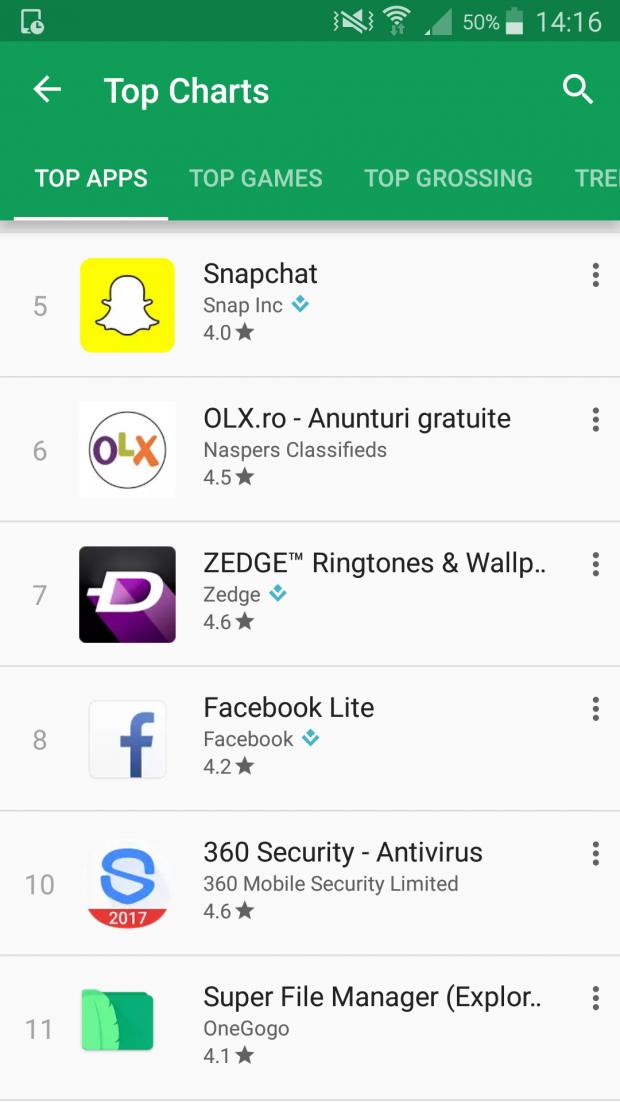The two biggest players in the app market are surely Google and Apple with their own dedicated stores for users to find and download applications for almost anything. While Google Play Store features a greater number of apps, the App Store is the place where developers can capitalize their work more.
Apple launched its App Store in 2008 when the iPhone 3G was announced. 500 apps were available at first, but within 5 years their number passed the 1 million milestone. Last quarter, Apple’s App Store saw a 60% year-on-year revenue growth, while the Play store grew by 82%, and the total number of apps reached 2.7 million in January 2017, compared to 2.2 million in the App Store.
The Play Store was launched in 2008, formerly known as Android Market, and it quickly outgrew the App Store and reached about 64 billion downloads in 2016, while the App Store recorded just a little over 25 billion downloads during the same year, according to App Annie.
Free and paid apps in stores
From a developer’s perspective, the best place to monetize an app is surely the App Store, considering that it generated $5.4 billion in revenue in Q4 2016, while the Play Store only managed to generate $3.3 billion in the same quarter.
Both the Play Store and the App Store offer the same revenue-sharing terms to developers, 70% of the amount paid by users goes to developers. However, since there are fewer apps in the App Store, developers could generate more revenue here compared to the Play Store.
Reports have shown that iOS users don’t mind paying for a reliable app, while the situation in the Play Store is quite different. Because many apps compete in the same category, developers tend to make their apps free in order to attract more users.
This poses an advantage for users, but not really for developers. To monetize on their apps, they would sometimes incorporate ads, which could drive some users to competing cleaner apps. Seeing how the size of the App Store is smaller, the competition isn’t that harsh. Paying a few dollars a month for a good app isn’t bothersome for iOS users, but it could drive some of them to the Play Store’s free alternatives.
Instant apps and beta testing
Google’s Play Store allows users to push app installation on all of their phones and tablets in an instant. If you want to install the same app on your iPhone and iPad, you’d have to do it manually for both devices. It’s not that big of an inconvenience, but it does make a difference in terms of usability.
Moreover, Google is currently testing Instant Apps for Android users. This means that users will no longer need to download an entire app in order to check out its content. Bits and parts of the app are installed on the device instantly, allowing users to access content and save space on the device.
Many times, users receive a message or tap on a link that can be opened only in a specific app. With Instant Apps, they no longer need to install an entire application just to see a picture or read an article. Apple’s iPhone users don’t have this functionality.
The Play Store also offers users the option to test out beta apps and get the latest features. Beta versions are sometimes unstable, but users can opt out of beta testing at any time.
Types of apps
Android mobile OS runs on an abundance of smartphones and tablets, with different CPUs, RAM capacity and display sizes. Android developers usually make their apps available to a greater number of devices, compared to iOS. While most apps in the App Store work both on iPhones and iPads, there are still some that are exclusive to smartphones and weren’t properly adapted to the larger screen of an iPad.
In terms of app categories, education, lifestyle, entertainment, business and personalization are the most popular in the Play Store. Users can find an abundance of apps that meet their needs, whichever that is. The phrase “There’s an app for that” launched by Apple a few years ago to promote its App Store has started applying to its main competitor, the Play Store.
Apple has a tendency to promote games on its App Store, which is where Apple makes a lot of revenue. One prolific case is that of the highly anticipated Super Mario Run which was launched on iOS first, while the Android version still hasn’t arrived yet.
To maximize the impact of their apps, many developers have launched versions for both iOS and the Play Store, but the latter has some more options. Play Store offers apps for customizing your rooted phone by automating certain commands using Tasker or other apps.
Reviews and refunds
Searching for an app is much easier on the Play Store, considering that Google excels in creating efficient search algorithms. Google also integrated Google+ features, so whenever you’re reading reviews for an app, those written by your friends appear at the top. Receiving a recommendation from a friend weighs more compared to reading reviews from complete strangers.
However, Apple has a system that promotes apps with ratings higher than 4 stars giving them a boost and improving their rank to make it easier for users to discover them. In addition, Apple is believed to work on a system that allows developers to ask users to rate an app just three times in a year. Some apps downloaded from the Play Store will ask users for ratings continuously.
Users who paid for apps downloaded from the Google Play Store can get a refund within 2 hours of making the purchase. The no-questions-asked refund policy is even more appealing on the App Store, with a 14-day return policy for customers in the European Union and other regions.
Security
They say the App Store is safer, and that might be true considering that Apple takes a lot of time to review each app individually. In fact, this is one of the main principles behind the store for iOS, applications are reviewed and receive a rating from Apple, a process that can take a little over a week. This way, Apple wants to make sure that apps in its store follow guidelines.
App Brain revealed that the number of low-quality apps reached 337,000 on the Play Store last month, but there aren’t any such numbers for iOS. Low-quality apps don’t necessarily contain malware, but they don’t improve user experience.
On the flip side, it’s much faster to publish apps on the Play Store, as long as they meet Android guidelines. There have been many cases in which malicious apps made it to the Play Store, Google would remove an app only if it’s reported by a number of people. Even though Apple reviews apps firsthand, that doesn’t mean they’re necessarily safer.
A prolific case was the XcodeGhost malware which infected 4,000 apps. In order to create an iOS app, developers must use Apple’s Xcode program which has a size of 3GB. In countries where Internet speed is quite slow, like China, it can take about an hour to download. Therefore, some developers downloaded the program containing the malware from third-party websites and thus infected their apps and the phones of users.
Conclusion
The Play Store and Android offers a lot more flexibility for users in terms of customization and types of apps, but the Apple Store has more secure apps. However, Apple’s App Store seems to be focusing on games, while the Play Store is filled with photo editing and education apps.
Android apps are clearly cheaper and there are completely free alternatives to any app that you might wish to check out. But in terms of security, iOS apps are safer, although there have been apps with malware in the App Store too. We’re leaning towards the Play Store, but let us know what your thoughts are.

 14 DAY TRIAL //
14 DAY TRIAL // 





